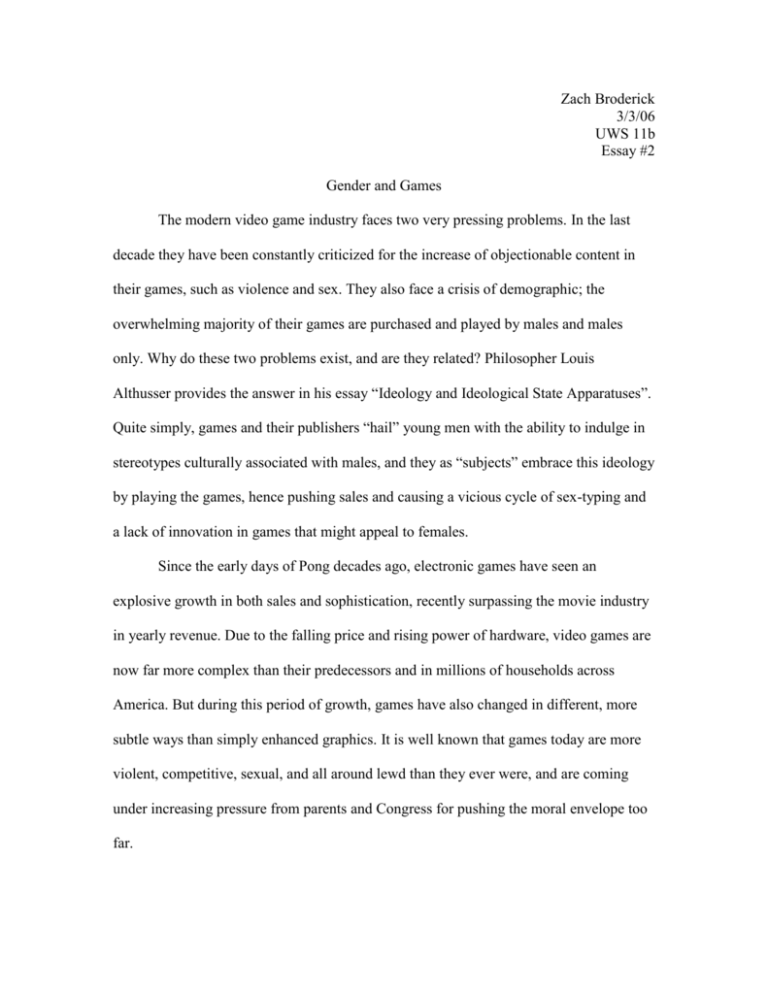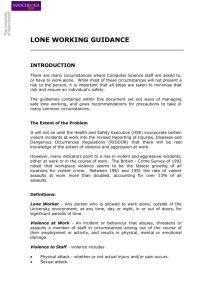Gender and Video Games
advertisement

Zach Broderick 3/3/06 UWS 11b Essay #2 Gender and Games The modern video game industry faces two very pressing problems. In the last decade they have been constantly criticized for the increase of objectionable content in their games, such as violence and sex. They also face a crisis of demographic; the overwhelming majority of their games are purchased and played by males and males only. Why do these two problems exist, and are they related? Philosopher Louis Althusser provides the answer in his essay “Ideology and Ideological State Apparatuses”. Quite simply, games and their publishers “hail” young men with the ability to indulge in stereotypes culturally associated with males, and they as “subjects” embrace this ideology by playing the games, hence pushing sales and causing a vicious cycle of sex-typing and a lack of innovation in games that might appeal to females. Since the early days of Pong decades ago, electronic games have seen an explosive growth in both sales and sophistication, recently surpassing the movie industry in yearly revenue. Due to the falling price and rising power of hardware, video games are now far more complex than their predecessors and in millions of households across America. But during this period of growth, games have also changed in different, more subtle ways than simply enhanced graphics. It is well known that games today are more violent, competitive, sexual, and all around lewd than they ever were, and are coming under increasing pressure from parents and Congress for pushing the moral envelope too far. It is also no secret that consumers of hardcore games (big budget console or PC games that require significant time and effort) are overwhelmingly male. In the twentyfirst century, video games are to males what dolls are to females. Ask any young man under 25 what he enjoys doing for fun, and chances are he will name video games fairly high up on the list. The same result is not likely, however, for young women. Coincidentally, the games industry attempts to target their games at this largely young, male demographic. Support for the thesis of this paper will rest on three main ideas in Althusser’s essay. Althusser states that “an ideology always exists in an apparatus, and its practice, or practices. This existence is material” (34). The practice I will be analyzing is the act of playing a video games, which includes not just mashing buttons but participating in the fantasy world a game creates. The ideologies are the cultural male stereotypes that these games appeal to—the violence, competition, sex, and lewdness. Secondly, Althusser believes that “all ideology hails or interpellates concrete individuals as concrete subjects” (36). This is what the rest of this paper shall attempt to prove—that video games “hail” young men by appealing to these stereotypes. Thirdly, Althusser writes “the individual is interpellated as a (free) subject in order that he shall (freely) accept his subjection” (37). We have already established this—the majority of the video game market is male dominated, and the majority of males play video games. Therefore, if they are in fact hailed, they freely respond to it and are therefore subjected by social power structures related to gender. So do video games hail young males? As I sit typing this paper, I will occasionally look up at the television, which is tuned in to Comedy Central, the most popular station among young males whose IQs are just a bit too high for MTV. Just a minute ago a commercial came on for a Playstation game called “Black”, one that I think provides valuable insight into my thesis. It starts with the camera panning around a mansion dining hall, following a spray of bullets as they explode every object in sight, from the dining table to the piano to the fireplace, eventually halting over a plasma TV showcasing footage from the game. This footage contains little more than a gun, perhaps the same one as from the mansion, blowing apart everything in sight. Eventually everything explodes, and the cover for the game is shown: the title “Black” in front of a background made up entirely of shells. Aside from the fact that it’s a shooter and things blow up, little information is conveyed about the game. Clearly, this commercial was supposed to appeal to the male stereotype within me, the one who wants to wreak havoc without consequence in a virtual environment. I wondered, though, if I had responded to this hailing. Out of curiosity, I minimized my paper to take a look at what games I had installed on my desktop computer. I currently had shortcuts to “Battlefield 2” and “Unreal Tournament 2004” on my computer, both celebrated titles in the world of electronic gaming, both also incredibly violent. In Battlefield you play a modern soldier in a major army as you use guns, rockets, tanks, and helicopters to destroy enemy forces. Unreal is a more traditional shooter, in which you are a lone warrior in a deathmatch arena and must use outlandish weapons to annihilate fellow competitors. I also remembered that I have a copy of “Black” in my Xbox back at school. Now, this could be taken as simply my taste in games. Indeed, I am a diehard fan of the first-person shooter genre. However, one only need look at a handful of the most popular titles in all genres to realize that violence and aggression are a key element in the majority of games today. Besides first-person shooters, which are inherently violent, you have fighting games such as the immensely popular Mortal Kombat and Soul Calibur; there are Real-Time Strategy games such as the best-selling Warcraft, which focus on war and conquering enemy lands; you have Role-Playing Games, such as Final Fantasy, in which you destroy foes in a fantasy setting; you have sports games like the best selling football simulator Madden ’06; even adventure games such as Zelda have you smiting your foes with swords and arrows, even if there is less blood. The Grand Theft Auto series are in a league of their own, allowing you to, among other things, massacre an innocent city in any way imaginable in your quest for gang supremacy. Why is every popular game genre violent by nature? The answer is that, in order to sell games to their must lucrative demographic, publishers hail young men into accepting the cultural stereotype (an ideology) that they enjoy violence. That is, they enjoy it in the sense of watching or participating in violent sports like boxing and football, or watching violent action movies or, in the case of video games, engaging in virtual violence of all sorts. Whether or not this stereotype accurately describes men, or whether is stems from nature or nurture, is irrelevant. Few would doubt that it exists in our society, and it becomes especially clear once revealed from the perspective of the games industry. Whether or not this perpetuates violent tendencies is still up in the air; studies on the effects of violence in video games are largely inconclusive. However, certainly the cultural effect of males accepting this ideology through video games impacts society significantly. Another way in which games hail men is through the stereotype that they are supposed to be competitive. Besides the obvious sports games, almost all hardcore games on the shelves are competitive in nature—if you are not competing with the computer by attempting to overcome enemy AI, you are either playing against someone else in your living room or a bunch of strangers over the internet. More often then not, you are killing these people brutally in a virtual world. There are a few games that are not competitive, such as the best selling “The Sims” and “Railroad Tycoon”; coincidentally, these are also the games most favored by women, not to mention the various low-budget puzzle games found in abundance on the internet. Again, men accept this competitive ideology—most home consoles have more than one controller plugged in, and the internet is teeming with data packets announcing the fate of international competitors. The most blatant act of stereotyping in games however is in the representations of the sexes. The heroes of most shooters are almost laughably similar—an (ex-)Marine, strong, silent, stoic—whose quest more often than not involves saving a damsel in distress (“Sorry Mario, the princess is in another castle”, “Link, you must save princess Zelda!”). In response to recent criticism, the game industry has tried to include empowered female stars or sidekicks in games, but these characters tend to be men in women’s bodies—scantily clad, large-breasted bodies. Even Lara Croft, gaming’s token heroine, has a rack that would make Pam Anderson jealous and lacks any of the basic body armor a male hero would undoubtedly have. This sex-typing stretches even further into rather bizarre, disturbing mixtures of sex and violence that would have Freud jumping for joy. Games such as “Dead or Alive” and “Soul Calibur” go beyond the basic stereotypes and feature hot, semi-nude women beating the crap out of each other. “Grand Theft Auto” and “Postal 2” takes it a step further with the ability to violently kill innocent women and prostitutes to your heart’s content. This is a particularly unhealthy ideology for men to embrace, and it reveals some disturbing aspects of our culture that I will not attempt to analyze. Suffice to say the gender roles of heroes and their quests are almost medieval in nature. Do not mistake this paper as a call for change of the wrong sort. I am an avid gamer, a fan of most of the titles I have named thus far. I enjoy the violence and competition, and I do not favor censorship or more “PC” games in any way. I stand behind GTA against all of its critics, and hope more games like it are made. My call for change echoes that of much of the games industry, which is a call for more sophisticated games, ones that appeal to both to men and women. Games with deeper stories, more complex heroes, and challenges other than just a high kill count. In this way, games can stop hailing men and start appealing to females as well, spawning the female market and ending the vicious cycle of male consumers, stereotypes, and game publishers.










